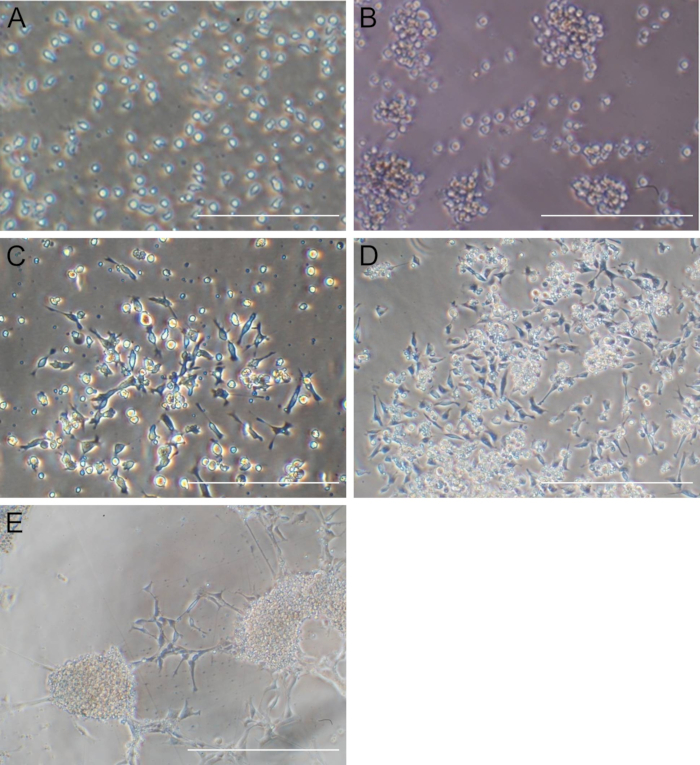Direct Reprogramming of Hematopoietic Progenitor Cells into Neural Stem Cells
Abstract
Source: Wang, T., et al. Direct Induction of Human Neural Stem Cells from Peripheral Blood Hematopoietic Progenitor Cells. J. Vis. Exp, (2015)
This video demonstrates the direct reprogramming of genetically modified hematopoietic progenitor cells into neuronal stem cells. Transcription factors expressed by hematopoietic progenitor cells trigger a cascade of molecular events facilitating their transformation. Further specific media is used to select and grow induced neuronal stem cells.
Protocol
1. Neural stem cell induction
NOTE: Depending on cell conditions, about 5 or 7 days after transfection, monolayer adherent cells will reach 30 – 50% confluence (Figure 1C).
- Remove the supernatants containing floating cells and spheres and then add 1 ml of neural progenitor medium (Dulbecco's Modified Eagle Medium: Nutrient Mixture F-12 (DMEM/F12), containing 1x N2 supplement, 0.1% (w/v) bovine serum albumin (BSA), 1% (v/v) antibiotics, 20 ng/ml of basic fibroblast growth factor (bFGF), and 20 ng/ml of epidermal growth factor (EGF)) into the adherent cells.
- Optionally, dissociate the cell spheres by gently pipetting and centrifuging the cells at 170 x g for 10 min. Remove the supernatant and resuspend the cells in 1 ml of neural progenitor medium in a new 24-well plate coated with matrigel per instruction as a backup.
- Change the medium every other day till the cells reach 60 – 80% confluent, usually after 1 week.
- Discard the supernatant and add in 1 ml of neural stem cell medium (serum-free medium, NSC SFM). Dissociate the cells using a cell scraper, followed by very gentle pipetting.
- Remove the cells and seed all of them into one well of a 6-well plate. Add another 1 ml of neural stem cell medium to make 2 ml media for each well. Incubate the cells at 37 °C in a 5% CO2 incubator.
- Change the medium every other day.
- When cells reach 60% confluence, dissociate and replate the cells at a 1:3 ratio following the steps in 1.4 and 1.6.
Representative Results

Figure 1. Morphological changes of CD34 cells after Sendai virus transfection. (A) Significant number of CD34 cells can be observed at the time of transfection. (B) Sphere-like cell aggregates can be observed 24 hr after Sendai virus transfection, which expands during time. (C) Mostly, bipolar adherent cells appeared after 5 days of transfection. (D and E) Typical morphologies of neural stem cells are shown after induction with neural progenitor medium and expansion. Scale bar: 200 µm for (A) and (B), 400 µm for the others.
Divulgations
The authors have nothing to disclose.
Materials
| Cell scraper | Sarstedt | 83.183 | |
| DMEM/F12 | Life technologies | 12400-024 | 1X |
| N2 supplement | Life technologies | 17502-048 | 1X |
| Bovine serum albumin | Sigma | A2934 | 0.1% (w/v) |
| bFGF | Peprotech | 100-18B | 20 ng/ml |
| EGF | Peprotech | AF-100-15 | |
| B27 supplement | Life technologies | 17504-044 | 1X |
| NSC serum free medium | Life Technologies | A1050901 | 1X |

